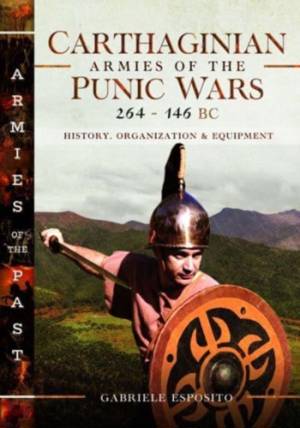
En raison d'une grêve chez bpost, votre commande pourrait être retardée. Vous avez besoin d’un livre rapidement ? Nos magasins vous accueillent à bras ouverts !
- Retrait gratuit dans votre magasin Club
- 7.000.000 titres dans notre catalogue
- Payer en toute sécurité
- Toujours un magasin près de chez vous
En raison de la grêve chez bpost, votre commande pourrait être retardée. Vous avez besoin d’un livre rapidement ? Nos magasins vous accueillent à bras ouverts !
- Retrait gratuit dans votre magasin Club
- 7.000.0000 titres dans notre catalogue
- Payer en toute sécurité
- Toujours un magasin près de chez vous
Carthaginian Armies of the Punic Wars, 264-146 BC
History, Organization and Equipment
Gabriele Esposito
34,95 €
+ 69 points
Description
Gabriele Esposito describes the organization, equipment and tactics of the Carthaginian forces that fought the three Punic wars with Rome, and analyzes the campaigns, battles and sieges.
The Carthaginians were undoubtedly the most formidable enemies of the ever-expanding Roman Republic, due to their sophisticated and often well-led military forces. Although the citizens of Carthage itself, a seafaring, mercantile state by tradition, may not have had the same military ethos as the Romans, they compensated by fielding varied multinational armies consisting of subject, allied and mercenary contingents, many of them recruited from the most famous warrior peoples of the Mediterranean. These included the incomparable Numidian light cavalry, the famed slingers of the Balearic islands, fierce Celts and skilled Spanish swordsmen, not forgetting the famous war elephants. During the first of the three conflicts that they fought against the Roman Republic - the famous Punic Wars - the Carthaginians completely reformed their land forces along Hellenistic lines and invited an experienced Spartan officer to command it. During the Second Punic War, they obtained a series of stunning victories over the Romans under the brilliant leadership of their own Hannibal Barca, marauding through Italy for some fifteen years.
Gabriele Esposito reconstructs the history, organization and weapons of the Carthaginian military forces across the Punic Wars (264-146 BC). The weapons, armor and tactics of each of the various ethnic components is analyzed and the accessible text is supported by dozens of excellent color photographs, showing replica equipment in use.
The Carthaginians were undoubtedly the most formidable enemies of the ever-expanding Roman Republic, due to their sophisticated and often well-led military forces. Although the citizens of Carthage itself, a seafaring, mercantile state by tradition, may not have had the same military ethos as the Romans, they compensated by fielding varied multinational armies consisting of subject, allied and mercenary contingents, many of them recruited from the most famous warrior peoples of the Mediterranean. These included the incomparable Numidian light cavalry, the famed slingers of the Balearic islands, fierce Celts and skilled Spanish swordsmen, not forgetting the famous war elephants. During the first of the three conflicts that they fought against the Roman Republic - the famous Punic Wars - the Carthaginians completely reformed their land forces along Hellenistic lines and invited an experienced Spartan officer to command it. During the Second Punic War, they obtained a series of stunning victories over the Romans under the brilliant leadership of their own Hannibal Barca, marauding through Italy for some fifteen years.
Gabriele Esposito reconstructs the history, organization and weapons of the Carthaginian military forces across the Punic Wars (264-146 BC). The weapons, armor and tactics of each of the various ethnic components is analyzed and the accessible text is supported by dozens of excellent color photographs, showing replica equipment in use.
Spécifications
Parties prenantes
- Auteur(s) :
- Editeur:
Contenu
- Nombre de pages :
- 160
- Langue:
- Anglais
- Collection :
Caractéristiques
- EAN:
- 9781399067546
- Date de parution :
- 23-11-23
- Format:
- Livre relié
- Format numérique:
- Genaaid
- Dimensions :
- 168 mm x 248 mm
- Poids :
- 657 g

Les avis
Nous publions uniquement les avis qui respectent les conditions requises. Consultez nos conditions pour les avis.






